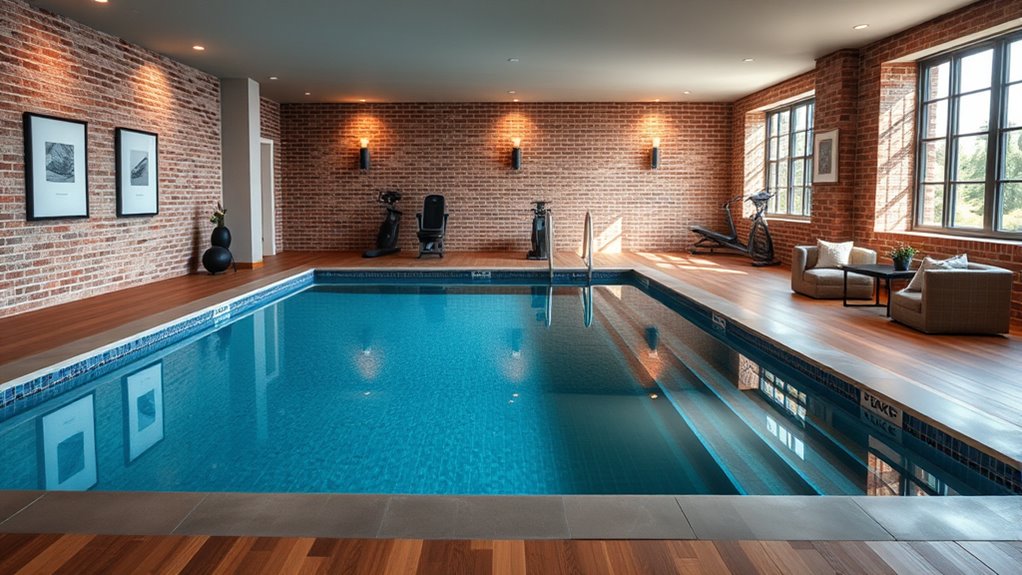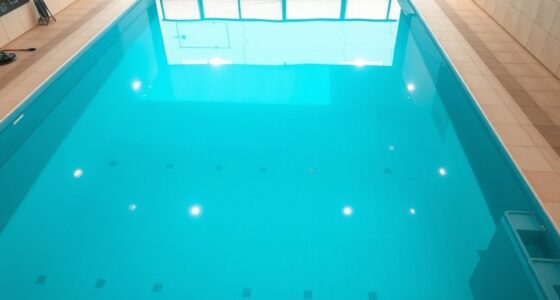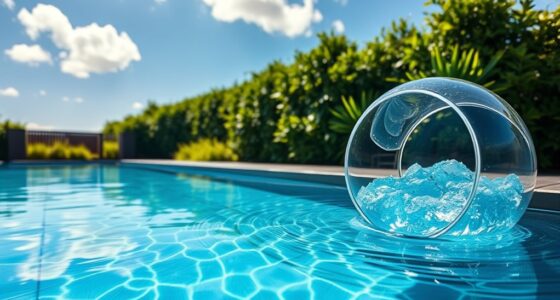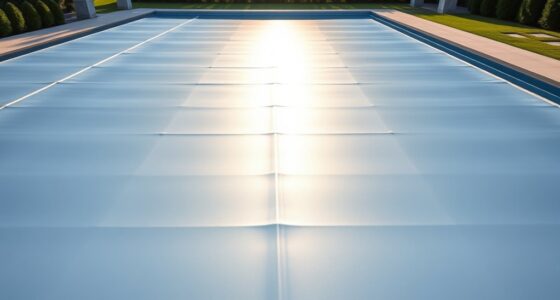Converting your garage or basement into an endless pool involves evaluating your space for size, ceiling height, and load capacity. You’ll need to plan a layout that ensures easy access, safety features, and proper ventilation. It’s important to choose energy-efficient equipment, meet electrical and plumbing codes, and consider insulation and moisture control. By carefully managing these factors, you can create a durable, functional pool space—continue exploring for detailed steps to make it happen.
Key Takeaways
- Assess space dimensions, ceiling height, and floor load capacity for suitable pool installation.
- Design layout considering safety, accessibility, ventilation, and storage solutions.
- Choose energy-efficient equipment and plan maintenance for water quality and system longevity.
- Ensure electrical wiring and plumbing meet local codes, with proper permits and safety features.
- Insulate, seal, and install climate control systems to maintain temperature and prevent moisture issues.
Assessing Space and Structural Considerations

Before installing an endless pool in your garage or basement, it’s essential to assess the available space and the structural capacity of your property. Measure the dimensions of the area carefully, ensuring there’s enough room for the pool itself and safe movement around it. Check the ceiling height to confirm it can accommodate the pool’s installation height and any necessary equipment. Additionally, evaluate the floor’s load-bearing capacity; a pool filled with water is heavy, so your foundation must support this weight without risk of damage. Inspect for existing structural issues like cracks or leaks. If unsure, consult a structural engineer to confirm your space can handle the additional weight and modifications needed for a safe, long-lasting installation. Considering foundation support is crucial to prevent future issues related to structural integrity.
Designing Your Endless Pool Layout
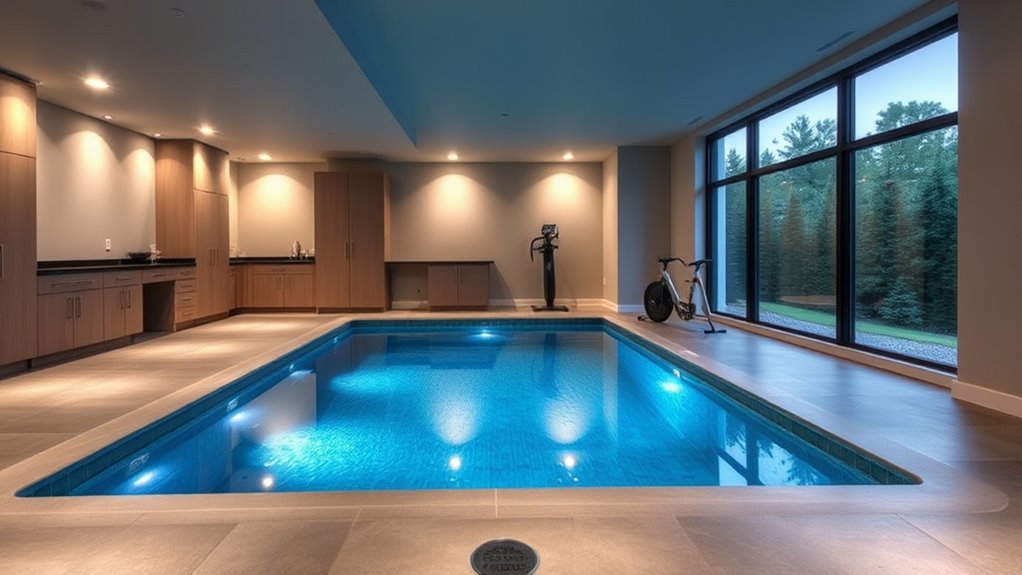
Designing your endless pool layout requires careful planning to optimize space, safety, and convenience. Start by considering the pool’s placement to ensure easy access and enough clearance around it. Think about the flow of movement, making sure there’s enough room for entering, exiting, and maintenance. Incorporate safety features like non-slip flooring and proper lighting. Decide if you’ll add seating or lounging areas nearby for relaxation. Consider ventilation and temperature control, especially in basements. Also, plan for storage options for accessories and cleaning supplies. Smart design principles can help create a balanced and functional layout that enhances your overall living space.
Choosing the Right Pool Equipment and Features

When selecting your pool equipment, focus on energy-efficient options to save on long-term costs. Consider water filtration systems that keep your pool clean with minimal maintenance, and explore customizable features to enhance your swimming experience. Making the right choices guarantees your Endless Pool is both practical and tailored to your preferences. Additionally, choosing equipment with regular maintenance features can help prevent common issues like clogs or leaks, ensuring consistent performance over time.
Energy Efficiency Options
Choosing energy-efficient pool equipment is essential for keeping operational costs low and reducing your environmental impact. Selecting the right features can make your pool more sustainable and save you money over time. Look for variable-speed pumps that adjust power based on demand, cutting energy use considerably. Insist on high-efficiency heaters to warm your pool with less electricity. LED lighting consumes less power and lasts longer. Invest in insulated covers to retain heat and reduce evaporation. Finally, choose automation systems that optimize circulation and temperature control, ensuring everything runs smoothly without wasting energy. These options help you create a more eco-friendly pool setup, lowering costs, and making your backyard oasis more sustainable. Additionally, understanding the importance of contrast ratio can aid in selecting projectors that maximize your home cinema experience, ensuring vibrant visuals with deep blacks and bright highlights.
Water Filtration Systems
Selecting the right water filtration system guarantees your pool stays clean, clear, and safe for swimming. You’ll want a system that effectively removes debris, bacteria, and algae while minimizing maintenance. Sand filters are common, offering reliable filtration and easy backwashing. Cartridge filters provide high-quality filtration with less water waste, making them ideal for smaller spaces. Diatomaceous earth (DE) filters offer the clearest water but require more frequent maintenance. Consider your pool size, usage, and budget when choosing a system. Automatic timers and multi-port valves can streamline operation. Regularly cleaning or replacing filters is essential to maintain water quality. Investing in a quality filtration system ensures your pool remains inviting, safe, and low-maintenance, making your conversion project worthwhile. Additionally, understanding Honda Tuning techniques can help optimize your vehicle’s performance, whether for daily driving or specialized modifications.
Customizable Features
Customizable features allow you to tailor your pool setup to fit your lifestyle, space, and budget. By selecting the right equipment and options, you can enhance your pool experience and ensure it meets your needs. Consider features like adjustable jets for personalized water flow, energy-efficient pumps to save on costs, LED lighting for ambiance, built-in seating for comfort, and automated cleaning systems for easy maintenance. These options help you create a pool that’s not only functional but also enjoyable. Think about how each feature aligns with your daily routine and space constraints. Customization lets you design a pool that maximizes your investment, providing convenience, comfort, and fun all in one. Additionally, understanding customizable features can help you make informed choices to transform your space into the perfect aquatic retreat.
Addressing Plumbing and Electrical Requirements

You’ll need to plan your plumbing system carefully to guarantee proper water supply and drainage. Additionally, your electrical wiring must meet safety standards and handle the pool’s power requirements. Don’t forget to check local permits and codes to keep your installation compliant and secure. Incorporating attention to detail can help prevent future issues and ensure a smoother installation process by following best practices in creative practice overview.
Plumbing System Setup
Installing the plumbing and electrical systems for your garage or basement Endless Pool requires careful planning to guarantee safety and functionality. You’ll need to verify proper water supply, drainage, and power connections to keep everything running smoothly.
Consider these key points:
- Confirm existing plumbing lines can handle the increased demand or plan for new lines.
- Install a dedicated drain for water removal and maintenance.
- Use high-quality, corrosion-resistant pipes suitable for continuous water exposure.
- Make sure your electrical system can support the pool’s pump and heater, following local codes.
- Incorporate shut-off valves for easy maintenance and emergency control.
- Consulting with a licensed professional can help ensure that your setup adheres to all safety standards and local regulations, especially when dealing with complex electrical requirements.
Proper setup minimizes leaks, prevents electrical hazards, and ensures your pool operates efficiently and safely.
Electrical Wiring Needs
Since your pool will require a dedicated electrical circuit, ensuring proper wiring is essential for safety and reliable operation. You’ll need to plan for a circuit that can handle the pool’s power requirements, including the pump, heater, and lighting. Use a GFCI (Ground Fault Circuit Interrupter) breaker to prevent electrical shocks. Make sure wiring runs through appropriate conduit to protect against moisture and physical damage. Consult a licensed electrician to confirm your setup meets local codes. Here’s a quick overview:
| Component | Power Requirement | Safety Feature |
|---|---|---|
| Pool Pump | 15-20 amps | GFCI breaker |
| Heater | 20-30 amps | Ground fault protection |
| Lighting | Low voltage | Proper grounding |
| Control Panel | N/A | Proper wiring layout |
| Power Supply | Dedicated circuit | Circuit breaker |
Permitting and Codes
Before beginning construction, understanding the local permitting and plumbing codes that apply to your pool installation is vital. These regulations ensure safety, proper installation, and legal compliance. Failing to follow codes can lead to fines or needing costly modifications later. You’ll need to check with your city or county about specific requirements, permits, and inspections. Be prepared to provide plans detailing plumbing and electrical setups. Hiring a licensed contractor familiar with local codes can streamline the process. Keep in mind that permits often require adherence to safety standards, proper drainage, and electrical grounding. Additionally, understanding sound healing science can help in designing spaces that promote relaxation and well-being around your pool area. Some key considerations include: – Obtaining necessary permits before work begins – Complying with plumbing installation standards – Meeting electrical wiring and grounding codes – Installing proper drainage and venting systems – Scheduling inspections at different project stages
Managing Water Quality and Filtration Systems

Effective management of water quality and filtration systems is essential to keep your pool clean, clear, and safe for use. You should regularly check and maintain your filtration system to guarantee it runs efficiently, filtering out dirt, debris, and bacteria. Use the appropriate pool chemicals, like sanitizers and pH adjusters, to balance water chemistry and prevent algae growth. Test water quality frequently with test strips or a digital tester, and make adjustments as needed. Keep the pool cover on when not in use to reduce debris and evaporation. Regularly clean the filter according to the manufacturer’s instructions to prevent clogs and maintain peak flow. Proper water management not only extends your pool’s lifespan but also guarantees a safe, enjoyable swimming experience. Staying informed about water quality standards can help you maintain an optimal swimming environment.
Insulation and Climate Control Strategies

Maintaining ideal water quality is just one part of ensuring your pool remains enjoyable year-round. Proper insulation and climate control are essential to keep the surrounding environment comfortable and energy-efficient. Insulate walls, floors, and ceilings to minimize heat loss and reduce heating costs. Consider installing a vapor barrier to prevent moisture issues. Use energy-efficient heaters and thermostats to maintain a stable temperature. Seal windows and doors tightly to prevent drafts. Additionally, installing a dehumidifier can help control humidity levels, protecting your space from mold and corrosion.
- Choose high-quality insulation materials suitable for your space
- Use programmable thermostats for precise temperature control
- Install weatherstripping around doors and windows
- Invest in energy-efficient heating systems
- Regularly check for drafts and seal gaps promptly
Ensuring Proper Ventilation and Moisture Management

Proper ventilation and moisture management are essential for keeping your garage or basement endless pool space comfortable and safe. Without adequate airflow, humidity levels can spike, leading to mold growth and structural damage. To prevent this, install a reliable exhaust fan or ventilation system that circulates fresh air and removes excess moisture. Use dehumidifiers to maintain ideal humidity levels—preferably between 50-60%. Regularly check for condensation on walls, ceilings, and equipment, and address any issues promptly. Keep the space dry by sealing cracks and leaks, and avoid bringing in damp equipment or materials. Proper ventilation not only improves air quality but also helps control humidity, ensuring your pool area remains safe, comfortable, and free from moisture-related problems.
Permitting, Codes, and Safety Regulations

Before installing an endless pool in your garage or basement, you need to guarantee you comply with local permitting requirements, building codes, and safety regulations. These rules ensure your project is legal, safe, and up to code. Failing to obtain necessary permits can lead to hefty fines or having to remove your pool later. Building codes specify structural, electrical, and plumbing standards to prevent hazards. Safety regulations include proper barriers, ventilation, and electrical safety measures.
Ensure your indoor pool project complies with local permits, codes, and safety regulations for a safe, legal installation.
- Check with your local building department for permit requirements
- Ensure structural integrity and proper load-bearing capacity
- Comply with electrical wiring and GFCI outlet codes
- Install safety barriers or covers to prevent accidents
- Follow ventilation standards for moisture and air quality
Maintenance and Long-Term Upkeep

Regular maintenance is essential to keep your endless pool functioning smoothly and to extend its lifespan. You should regularly check and clean the filters, balance chemical levels, and inspect the pump and heater for signs of wear. Draining and cleaning the pool periodically prevents build-up of debris and algae. Proper upkeep ensures water quality and equipment longevity. To help guide your maintenance routine, consider this table:
| Task | Frequency | Important Tips |
|---|---|---|
| Filter Cleaning | Weekly | Remove debris, rinse thoroughly |
| Chemical Testing | 2-3 times per week | Maintain proper pH and sanitizer levels |
| Equipment Inspection | Monthly | Check for leaks or unusual noises |
| Water Drain & Clean | Quarterly | Remove sediments and algae |
| Cover Maintenance | Annually | Inspect for tears, clean cover |
Frequently Asked Questions
What Is the Average Cost to Convert a Garage or Basement Into an Endless Pool?
You can expect to spend between $50,000 and $150,000 to convert a garage or basement into an endless pool. Costs vary depending on factors like pool size, design, and the complexity of the installation. You’ll need to budget for excavation, waterproofing, HVAC adjustments, and electrical work. Planning ahead and consulting with professionals can help you get accurate estimates and make certain your space is ready for your new pool.
How Long Does the Installation Process Typically Take?
The installation usually takes between 4 to 8 weeks, depending on your space and project scope. You’ll start with planning and permits, then move to construction and equipment setup. During this time, expect some disruption as the space is transformed. Staying involved and communicating with your contractor helps make certain the process stays on schedule. Once completed, you’ll enjoy your new endless pool in just a few months.
Can Existing Structures Support the Weight of a Filled Pool?
Yes, existing structures can usually support the weight of a filled pool, but you should have a professional assess your space first. They’ll check the floor’s load-bearing capacity and may recommend reinforcement if needed. Keep in mind, a filled pool can weigh thousands of pounds, so ensuring your garage or basement’s foundation is solid is essential for safety and long-term durability.
Are There Specific Insurance Considerations for Indoor Pools?
Yes, there are specific insurance considerations for indoor pools. You should inform your insurer about the pool’s installation to guarantee proper coverage. Homeowners insurance might increase due to potential risks like water damage, liability, or accidents. Installing safety features such as covers, alarms, and barriers can help lower premiums. Always review your policy and discuss with your insurer to understand coverage options and avoid surprises if an incident occurs.
What Are Common DIY Challenges During Conversion Projects?
You’ll face challenges like ensuring proper waterproofing to prevent leaks and water damage. Managing electrical wiring safely is essential, so you need to follow codes and possibly hire an electrician. You might struggle with space limitations, making it tough to install plumbing or ventilation systems. Additionally, coordinating permits and inspections can slow progress. Planning ahead, researching requirements, and being patient will help you overcome these common DIY hurdles smoothly.
Conclusion
So, whether you turn your garage or basement into your personal aquatic paradise, just remember: it’s all fun and games until the water leaks, the electrical shorts, or the neighbors complain about the noise. But hey, who needs a yoga studio when you can swim laps in your converted closet? Just keep an eye on those permits, and maybe invest in some earplugs. Happy swimming—your new indoor oasis awaits!
